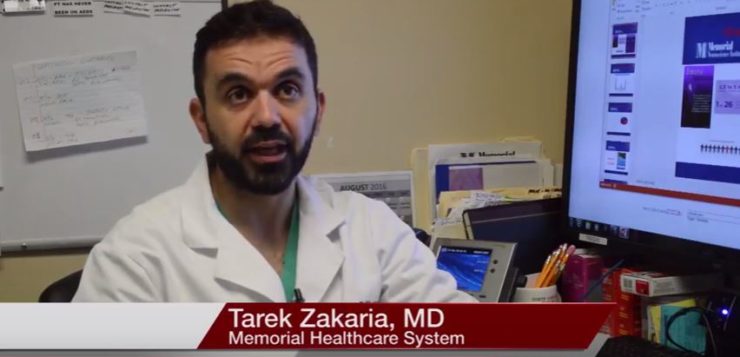Tarek Zakaria, M.D., Director of Memorial Comprehensive Epilepsy Program and Neurology Division of the Neuroscience Institute at Memorial Healthcare System in Fort Lauderdale, Florida, talks about a new device that is changing the lives of people living with epilepsy.
Interview conducted by Ivanhoe Broadcast News in August 2016.
Tell me a little bit about why we’re talking today; is this device newer, who does it help and what does it do?
Dr. Zakaria: Sure. We’re talking today about epilepsy and epilepsy is a very common problem. It’s estimated around three million Americans live every day with epilepsy. And what’s challenging, in regard to epilepsy treatment is that maybe fifty or forty percent of these patients will continue to have seizures on a very frequent basis despite being treated with different medications. There is a huge need to find not only a treatment that will help to stop the seizures, but also to minimize the side effects of the medications they are taking and improve their quality of life. Here’s where the NeuroPace comes in. The NeuroPace is one of the major breakthroughs that I believe happened in the field of epilepsy for the last ten years. NeuroPace is a new device that was approved by the FDA in the last few years. The device we’ll be able to monitor the brain activity. We will be able to screen this activity, detect any changes in the brainwaves and be able to respond to any kind of changes right there and early on in order to terminate or stop the seizure before it’s progressed into a full blown seizure. It’s very similar to the pacemaker of the heart, but it’s in the brain.
What results that you have seen firsthand? I know we’re going to meet a patient a little later on today but could you kind of sum up her success story?
Dr. Zakaria: Based on a lot of studies and trials that have been done in the last few years, we know that a NeuroPace can help stop the seizures completely and up to twenty percent of these patients who had the procedure. But what’s more important is that it does help to reduce the frequency of the seizures to maybe fifty or sixty percent compared to before the procedure. A lot of patients see significant reduction of their seizure frequency and they see huge improvement of their quality of life on the device.
Is there anything else you want to add before you show me anything?
Dr. Zakaria: The device is very much similar to like I said, a pacemaker of the heart. It consists of a small implanted pacemaker that would be placed right underneath the skin on the head. There will be two small wires that will be attached to the pacemaker and these wires will be placed on the surface of the brain where we think the seizures are coming from. These wires will be able to monitor the brain activity continuously, it will be able to screen and detect any changes in these brainwave activities; and we’ll be able to respond by sending impulses to the brain to terminate the seizures if and before the patients feel the seizures coming on and this will help to stop the seizure.
You can actually look and see how somebody is reacting at anytime and anywhere, correct?
Dr. Zakaria: That’s correct. One of the fascinating features of the device is that it will store all these brainwave activities and the patient can transmit this data into the server and I will be able to log in and look at his brainwave activity for the last month, or two months, or three months; as when the device has been implanted. I will be able to tell when and how many seizures they’ve been having and what we can do to improve our detection setting. We can generate these impulses right on even before the seizure progress so we can help to terminate the seizures.
Is it safe to say, you can follow up without making a doctor’s appointment? You can log on line and you can see how progress is being made; you don’t really need to pick up the phone or come in, it’s all right there to see.
Dr. Zakaria: Right, that’s a hundred percent correct, but we still work with the patient very closely because when we change any of the detection setting or the treatment options we have to interrogate the program and the pacemaker to be able for these changes to take place.
Is there anything else?
Dr. Zakaria: I want to finish this by saying; I mean we are looking for a group of patients who continue to have seizures on almost a daily or weekly basis. Most of these patients are taking a lot of seizure medications and they are experiencing the seizures, they are experiencing the side effect of the seizures and they have almost significant reduction in their quality of life. I think this device creates a huge hope for us in order to try to stop the seizures, try to make the patient seizure free and also try to minimize the numbers of the medication and the effects, the side effects on their quality of life.
END OF INTERVIEW
This information is intended for additional research purposes only. It is not to be used as a prescription or advice from Ivanhoe Broadcast News, Inc. or any medical professional interviewed. Ivanhoe Broadcast News, Inc. assumes no responsibility for the depth or accuracy of physician statements. Procedures or medicines apply to different people and medical factors; always consult your physician on medical matters.
If you would like more information, please contact:
Lourdes Rodriguez-Barrera
Manager of Corporate Communications
954-265-5465
lrodriguezbarrera@mhs.net
Sign up for a free weekly e-mail on Medical Breakthroughs called First to Know by clicking here.




